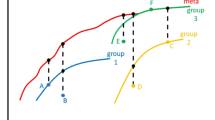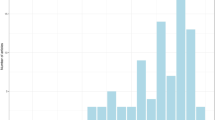Abstract
This chapter reviews different ways of comparing the efficiency frontiers for subgroups within a data set, specifically program efficiency, the metatechnology (or technology gap) ratio and the global frontier difference index. The latter is subsequently used to define a global Malmquist index, as well as in an alternative decomposition of the traditional Malmquist index which also considers socalled favourability and favourability change components, indicating whether individual observations are located in favourable positions in the production space based on the extent of frontier shifts they observe. The various approaches are illustrated in an empirical case of Ghanaian banks.
Access this chapter
Tax calculation will be finalised at checkout
Purchases are for personal use only
Similar content being viewed by others
References
Asmild M, Ohene-Asare K (2014) Considering favourability indexes as part of the Malmquist index, MSAP working paper 01/2014
Asmild M, Tam F (2007) Estimating global frontier shifts and global Malmquist indices. J Prod Anal 27:137–148
Asmild M, Bogetoft P, Nielsen K (2012) Are high labour costs destroying the competitiveness of Danish dairy farmers? Evidence from an international benchmarking analysis, MSAP working paper 01/2012
Battese GE, Rao DSP, O’Donnell CJ (2004) A metafrontier production function for estimation of technical efficiencies and technology potentials for firms operating under different technologies. J Prod Anal 21:91–103
Battese GE, Rao DSP, O’Donnell CJ (2008) Metafrontier frameworks for the study of firm-level efficiencies and technology ratios. Empir Econ 34:231–255
Brockett PL, Golany B (1996) Using rank statistics for determining programmatic efficiency differences in data envelopment analysis. Manage Sci 42(3):466–472
Charnes A, Cooper WW, Rhodes E (1978) Measuring the efficiency of decision making units. Eur J Oper Res 2:429–444
Charnes A, Cooper WW, Rhodes E (1981) Evaluating program and managerial efficiency: an application of data envelopment analysis to program follow through. Manage Sci 27(6):668–697
Cooper WW, Seiford LM, Zhu J (eds) (2004) Handbook on Data Envelopment Analysis. Taylor & Francis, Kluwer Academic Publishers, Norwell, US
Färe R, Grosskopf S, Lindgren B, Roos P (1994) Productivity developments in Swedish hospitals: a Malmquist output index approach. In Charnes A, Cooper WW, Lewin AY, Seiford LM (eds) Data envelopment analysis: theory, methodology and applications. Kluwer Academic Publishers, Boston
Oh D (2010) A global Malmquist-Luenberger productivity index. J Prod Anal 34(3):183–197
Pastor JT, Lovell CAK (2005) A global Malmquist productivity index. Econ Lett 88(2):266–271
Pastor JT, Asmild M, Lovell CAK (2011) The Biennial Malmquist Productivity Change Index. Socio-Econ Plan Sci 45:10–15
Paton D, Swann GMP, Thompson S, Girma S, Asmild M, Hanley A (2007) Competitiveness in the UK electronics sector. Report for the UK Department of Trade and Industry: Industry Economics and Statistics Division, May 2007
Simpson G (2007) A cautionary note on methods of comparing programmatic efficiency between two or more groups of DMUs in data envelopment analysis. J Prod Anal 28:141–147
Sueyoshi T, Aoki S (2001) A use of a nonparametric statistic for DEA frontier shift: the Kruskal and Wallis rank test. Omega Int J Manage Sci 29:1–18
Tohidi G, Razavyan S (2013) A circular global profit Malmquist productivity index in data envelopment analysis. Appl Math Model 37(1–2):216–227
Tohidi G, Razavyan S, Tohidnia S (2012) A global cost Malmquist productivity index using data envelopment analysis. J Oper Res Soc 63(1):72–78
Author information
Authors and Affiliations
Corresponding author
Editor information
Editors and Affiliations
Rights and permissions
Copyright information
© 2015 Springer Science+Business Media New York
About this chapter
Cite this chapter
Asmild, M. (2015). Frontier Differences and the Global Malmquist Index. In: Zhu, J. (eds) Data Envelopment Analysis. International Series in Operations Research & Management Science, vol 221. Springer, Boston, MA. https://doi.org/10.1007/978-1-4899-7553-9_16
Download citation
DOI: https://doi.org/10.1007/978-1-4899-7553-9_16
Published:
Publisher Name: Springer, Boston, MA
Print ISBN: 978-1-4899-7552-2
Online ISBN: 978-1-4899-7553-9
eBook Packages: Business and EconomicsBusiness and Management (R0)




